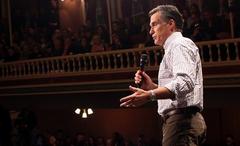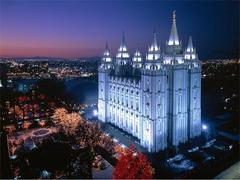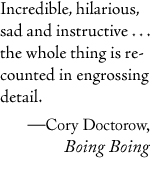As the Republican National Convention gets into full swing today, one of the topics that probably won't be talked about very much is Mitt Romney's religion. It's odd that this has become such a non-issue during the campaign, given that a) Romney is the first Mormon ever to receive a major-party presidential nomination, and b) the Mormon Church is the fourth largest church in America.
Wait, what? The fourth largest?
Yes, I too was startled by that statistic, which I've been hearing time and again from various outlets—for instance, in an "On the Media" story from late last year about the LDS Church's "I'm a Mormon" ad campaign. I was catching up on that episode via podcast when this statement from LDS Internet and Advertising Senior Manager Ron Wilson caught my ear:
Even though the Church of Jesus Christ of Latter-day Saints is the fourth largest church, fifty percent of the population didn't really know who we were.
The fourth largest church. I was raised Mormon, which means I was raised with the Mormon inferiority complex. Somehow that assertion didn't strike me as quite right. It sounded like a small man reporting his height in inches, not feet. I decided to do some digging.
In the strictest sense, I discovered, the statistic turns out to be absolutely true. The Mormon Church is the fourth largest church in America. Thing is, that number on its own doesn't mean quite what it seems to imply. Calling something the fourth largest of anything is a good way to make it sound significant, but of course its significance depends entirely on a) the sizes of the larger somethings, and b) the method you use for counting.
So let's examine the numbers. You'd expect the fourth largest church in the country to represent a significant fraction of the population. According to the 2012 Yearbook of American and Canadian Churches, the Mormon Church reported a total of 6,157,238 members in the United States in the year 2011. That's a lot of people, no doubt, but out of an estimated 311,800,000 Americans, that's just a hair under 2% of the population, or about 1 in every 50.
By contrast, the largest church in the country, the Catholic Church, reported 68,202,492 members. That's nearly 22% of the population, and more than 11 times the American membership of the Mormon Church. Running a distant second is the Southern Baptist Convention, with 16,136,044 members (5.2%), followed by the United Methodist Church at 7,679,850 members (2.5%).
But this begs the question of how a "church" is defined. In the case of the 2012 Yearbook of American and Canadian Churches, what we're talking about is organized religions. This means that the Southern Baptist Convention is counted separately from the National Baptist Convention, U.S.A., Inc. (5,197,512), which is itself counted separately from the National Baptist Convention of America, Inc. (3,500,000), and from the National Missionary Baptist Convention of America (2,500,000).
In all, there are six different Baptist denominations listed in the Yearbook's top 25, with a combined membership of 29,651,610 (over 9.5% of U.S. population). Similarly, the three Methodist denominations listed in the top 25 total 11,579,850 members (3.7%).
Moving on down the list, we realize that when we ask which has the larger membership, the Church of Jesus Christ of Latter-day Saints or the Evangelical Lutheran Church in America (4,274,855), the answer is the LDS Church. But if we ask whether there are more Mormons or Lutherans (6,553,441) in the country, the answer is Lutherans. And mind you, I'm only looking at the top 25 denominations, which account for a little under half the population of the country!
(And yes, I know there are other Mormon sects—notably the Community of Christ, with about 250,000 members worldwide. It's hard to get an accurate count, but altogether these sects would appear to number less than 350,000 throughout the entire world, so they don't really change the math by much.)
So far, our analysis has dropped Mormons down to fifth place, if we're talking about broad families of denominations. But what about the Evangelical movement? According to a 2008 study by the Pew Forum on Religion & Public Life, 26.3% of Americans, or more than a quarter of the population, identified themselves as Evangelical. Though countless small churches make up that number, taken as a whole the Evangelicals form the largest religious movement in the country, larger even than Catholicism. This drops Mormons to an ever more distant sixth place in the national standings.
The point is, simply saying that the Mormon Church is the fourth largest in the country, while technically true, implies that it's far more significant a player than it actually is. Out of every 100 people in the United States, 26 are Evangelical, 22 are Catholic, nearly 10 are Baptist, almost 4 are Methodist, more than 2 are Lutheran, and a bit fewer than 2 are Mormon.
By pointing this out, I'm not saying there aren't a lot of Mormons in America. Six million is clearly a large number. It's just not nearly as large as you might expect from the oft-repeated statistic. In fact, the figure of one Mormon in every 50 Americans pretty much implies that, out of 50 states, we have exactly one state's worth of Mormons in the country. Which we all pretty much knew anyway.
So let the Mormon Church continue to aggrandize itself with a misleading statistic. We've had a Quaker president in the past, and Quakers don't even come close to making the top 25. The truth is, maybe Mitt Romney's religion isn't all that big a story after all.
UPDATE: Thanks to Eleanor Lang for pointing out that Herbert Hoover was also a Quaker. That's two past U.S. presidents from a denomination that's about 18 times smaller than Mormonism.
Crossposted from Inhuman Swill




